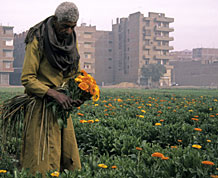RESPONSES TO INFORMAL AREAS
Since the 1970s, the Egyptian Government has been adopting two common policies for dealing with informal areas:
- First, the demolition and redevelopment of slum pockets â particularly in the case of squatting on public land
- Second, the upgrading of consolidated informal settlements with installation of infrastructure and services
Public and private investment in informal area development and upgrading
Public efforts to upgrade informal urban areas started in 1993, with a budget of roughly 4.5 billion EGP (1993-2002). This budget was aimed towards the physical upgrading of informal areas, managed at the Governorate level, but did not include investments in human, economic, and cultural development. Overall public investment into physical infrastructure (water, waste water, roads, electricity, 1993-2002) is reported to have been 2.3 billion EGP nationwide, and 1.2 billion EGP for the Greater Cairo Region.
Overall, informal investments in Egyptian housing and infrastructure have been significant:
| Total, informal housing stock (urban and rural): | 845 billion EGP |
| Total, urban informal housing stock: | 685 billion EGP |
| Total, Greater Cairo region: | 280 billion EGP |
(Source: ECES, 1997, 1 US$ = 3.5 EGP)
The cost of physical upgrading (water, waste water, roads, electricity) represents less than 10% of the total expenditure for public housing schemes. Estimated investment needs vary between 500 and 1,100 EGP per inhabitant. To provide sufficient services for the current population of informal areas, estimates for required investment needs vary between 2 and 18.5 billion EGP. In addition, all housing constructed under public housing schemes between the 1950s and 80s will need thorough upgrading by 2025.
Containment strategies
More recently, the General Organisation for Physical Planning (GOPP) has been promoting a third policy referred to as  ’containment‘, which aims to stop informal growth by applying targeted planning in areas surrounding those informal areas that are still growing, such as for example a major road that would put a halt to expansion. However, informal area growth persists besides planning barriers and the Egyptian Government is trying to limit the upsurge of informal areas by offering the planned extension of housing areas on desert land. Housing schemes are pursued in the 22 ‘New Towns‘ built in the desert. However, such new settlements are filling up very tentatively because they are not attractive to poor and low income households or, as in the cases of 6th of October and New Cairo, tend to favour high income residents and business. They lack the intrinsic social patterns of solidarity that have developed in many informal areas and create a sense of home for its residents.
Towards participatory urban development
Centrally-steered attempts to solve Egyptâs urban problems have not yielded sustainable results. Informal urbanisation on scarce agricultural land prevails despite strict laws. Throughout recent years, urban development strategies have turned more towards participatory approaches that involve citizens in planning processes – a trend PDP supports and fosters.
Â
